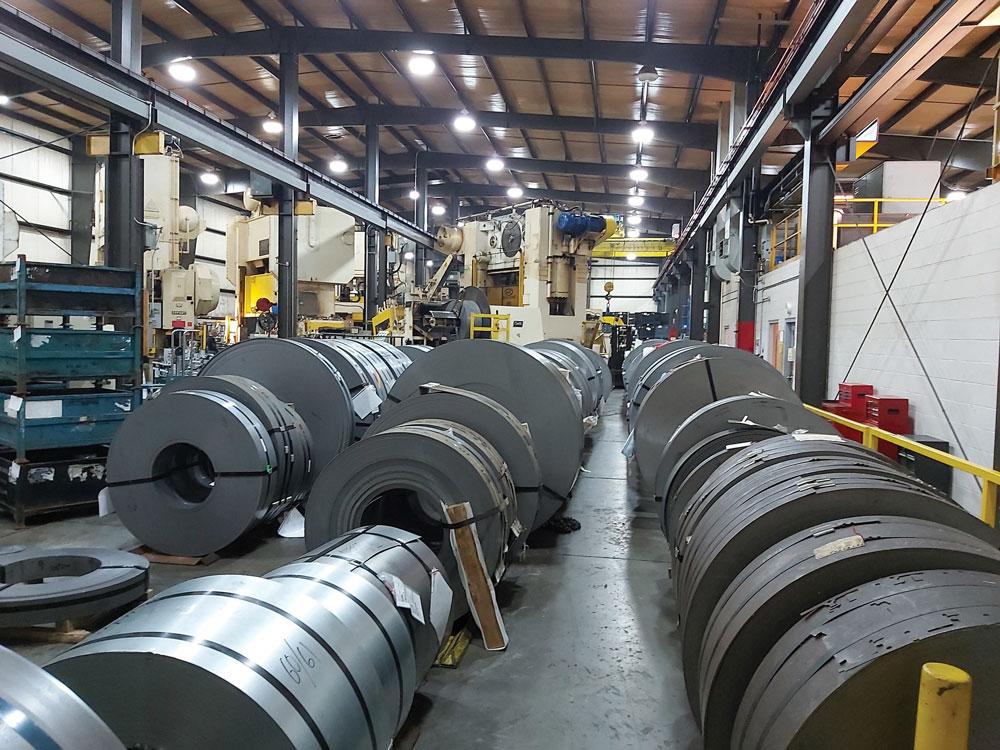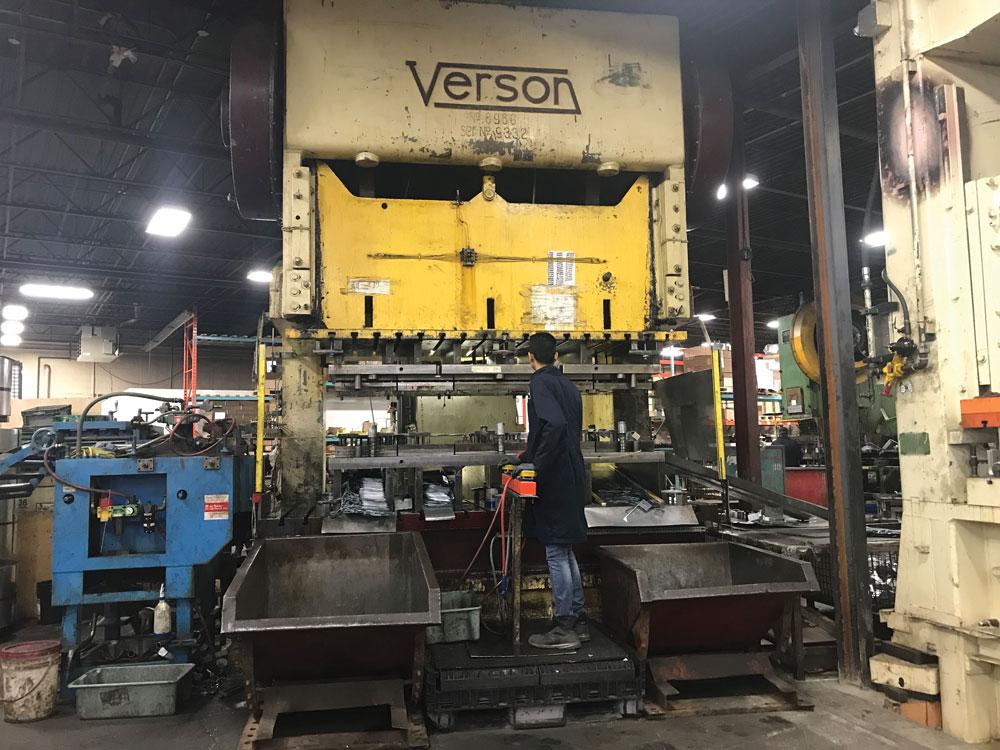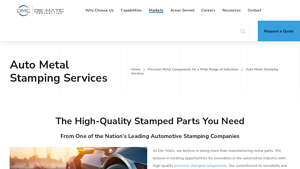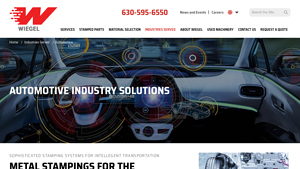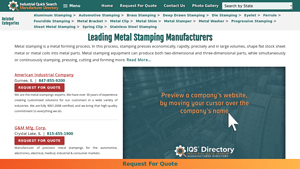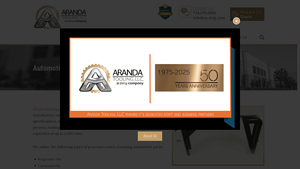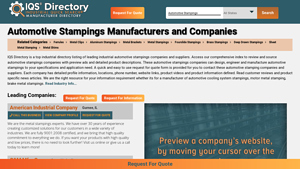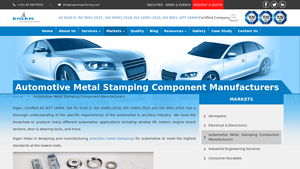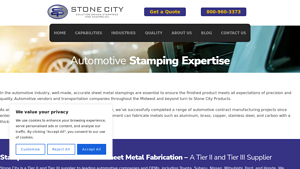Automotive Stamping Companies Guide: Type, Cost, Top List…
Introduction: Navigating the Global Market for automotive stamping companies
In the rapidly evolving landscape of the automotive industry, sourcing reliable automotive stamping companies can present significant challenges for international B2B buyers. With fluctuating trade conditions, varying regulations across borders, and an increasingly competitive market, understanding where to find quality suppliers and how to navigate these complexities is crucial. This guide serves as a comprehensive resource, providing insights into the types of automotive stamping services available, their applications across various vehicle segments, and essential supplier vetting criteria.
Moreover, we delve into cost considerations, helping buyers evaluate pricing structures and identify value-driven partnerships. By offering a detailed overview of key players in the market, production capabilities, and technological advancements, this guide empowers B2B buyers from Africa, South America, the Middle East, and Europe—specifically countries like Germany and Nigeria—to make informed purchasing decisions.
Whether you are seeking innovative solutions for electric vehicles or robust components for traditional models, our guide equips you with the knowledge and tools necessary to identify trustworthy automotive stamping suppliers that align with your business needs and operational goals. Let us help you navigate the global market landscape effectively, ensuring your automotive projects are built on a foundation of quality and reliability.
Understanding automotive stamping companies Types and Variations
| Type Name | Key Distinguishing Features | Primary B2B Applications | Brief Pros & Cons for Buyers |
|---|---|---|---|
| Tier 1 Stamping Suppliers | Direct suppliers to OEMs; high-volume production | Complete assemblies, structural components | Pros: High reliability, established quality standards; Cons: Higher costs, less flexibility in customization. |
| Tier 2 Stamping Suppliers | Provide parts to Tier 1 suppliers; more specialized | Specific components and sub-assemblies | Pros: Competitive pricing, more customization options; Cons: Potentially longer lead times, less direct relationship with OEMs. |
| Prototype Stamping Firms | Focus on prototyping and low-volume production | Development and testing of new designs | Pros: Fast turnaround, tailored solutions; Cons: Higher per-unit costs, limited scalability. |
| Progressive Die Stamping | Use of progressive dies for complex parts | High-volume production of intricate components | Pros: Consistent precision, efficient for large runs; Cons: Initial tooling costs can be high. |
| Value-Added Assembly Companies | Integrate assembly processes into stamping services | Complete systems and assemblies for vehicles | Pros: Reduced overall production time, streamlined supply chain; Cons: May require higher investment and longer lead times. |
What Are Tier 1 Stamping Suppliers and Their Role?
Tier 1 stamping suppliers are critical players in the automotive supply chain, directly supplying Original Equipment Manufacturers (OEMs) with high-volume stamped components and assemblies. Their facilities are typically equipped with advanced technologies and machinery capable of meeting stringent quality standards. B2B buyers looking for reliability and consistency in large orders often prefer these suppliers, although they may encounter higher costs and less flexibility in customization.
How Do Tier 2 Stamping Suppliers Differ?
Tier 2 stamping suppliers focus on providing specialized parts to Tier 1 suppliers, often engaging in smaller production runs. They can offer more competitive pricing and greater customization options, making them attractive to businesses that require specific components or sub-assemblies. However, buyers should be aware that lead times may be longer, and the relationship with OEMs is less direct.
What Advantages Do Prototype Stamping Firms Offer?
Prototype stamping firms specialize in creating low-volume parts and prototypes, making them ideal for businesses in the design phase of new products. They provide rapid prototyping services, allowing companies to test and refine their designs before committing to mass production. While these suppliers excel in flexibility and quick turnaround times, buyers should consider the higher per-unit costs and limited scalability for larger projects.
What Is Progressive Die Stamping and Its Benefits?
Progressive die stamping is a technique that allows for the efficient production of complex metal parts through a series of progressive steps in a single press. This method is particularly beneficial for high-volume production runs, ensuring consistent precision across large quantities. While the initial tooling costs can be substantial, the long-term benefits of efficiency and accuracy make it a worthwhile investment for companies needing intricate components.
How Do Value-Added Assembly Companies Enhance Production?
Value-added assembly companies integrate assembly processes into their stamping services, allowing for the production of complete systems or assemblies for vehicles. This integration can streamline the supply chain and reduce overall production time. However, buyers should be prepared for potentially higher investments and longer lead times due to the complexity of these operations. This option is ideal for companies looking to simplify their manufacturing process while ensuring high-quality outputs.
Key Industrial Applications of automotive stamping companies
| Industry/Sector | Specific Application of Automotive Stamping Companies | Value/Benefit for the Business | Key Sourcing Considerations for this Application |
|---|---|---|---|
| Automotive Manufacturing | Production of body panels and structural components | Enhances vehicle durability and safety | Quality certifications, material specifications |
| Electrical Components | Stamping of busbars and connectors | Ensures efficient electrical conductivity | Compliance with electrical standards, lead times |
| Consumer Electronics | Metal housings for electronic devices | Provides protection and aesthetic appeal | Precision requirements, volume capabilities |
| Aerospace | Stamping of lightweight components | Reduces aircraft weight, improving fuel efficiency | Material strength, regulatory compliance |
| Agricultural Machinery | Fabrication of chassis and frames | Increases robustness and longevity of machinery | Customization options, sourcing local materials |
How Are Automotive Stamping Companies Used in Automotive Manufacturing?
In the automotive manufacturing sector, stamping companies produce essential body panels and structural components, such as hoods, fenders, and chassis parts. These components are critical for vehicle integrity, performance, and safety. For international buyers, particularly in regions like Africa and South America, it is vital to ensure that the stamping companies hold relevant quality certifications and can meet specific material specifications to align with local automotive standards.
What Role Do Automotive Stamping Companies Play in Electrical Components?
Automotive stamping companies are also pivotal in the production of electrical components, such as busbars and connectors. These stamped parts are designed to ensure efficient electrical conductivity and reliability in automotive systems. Buyers from the Middle East and Europe should prioritize suppliers that comply with stringent electrical standards and can deliver on tight lead times to maintain production schedules and minimize downtime.
How Are Automotive Stamping Companies Involved in Consumer Electronics?
In the consumer electronics industry, automotive stamping companies manufacture metal housings for electronic devices, providing both protection and aesthetic value. These housings must meet precise dimensional and performance specifications to ensure compatibility with various electronic components. Buyers must consider the supplier’s ability to meet high precision requirements and their capacity for both low and high-volume production runs.
Why Are Automotive Stamping Companies Important in Aerospace?
In the aerospace sector, stamping companies produce lightweight components that significantly contribute to overall aircraft weight reduction, enhancing fuel efficiency. For international buyers in Europe, the emphasis is on sourcing from companies that utilize advanced materials and adhere to strict regulatory compliance standards to ensure safety and performance in aviation applications.
How Do Automotive Stamping Companies Support Agricultural Machinery?
Automotive stamping companies also fabricate chassis and frames for agricultural machinery, which must be robust to withstand harsh operational conditions. Buyers, especially in emerging markets like Nigeria, should seek stamping partners that offer customization options and have the capability to source local materials, ensuring that the components are tailored to specific agricultural applications while supporting local economies.
3 Common User Pain Points for ‘automotive stamping companies’ & Their Solutions
Scenario 1: Navigating Tariff and Trade Complexities in Automotive Stamping
The Problem: B2B buyers in the automotive sector often grapple with the repercussions of international tariffs and trade regulations. For instance, manufacturers sourcing stamped components from overseas may face unexpected costs due to tariffs, particularly on critical materials like steel and aluminum. This situation not only complicates budgeting but can also disrupt supply chains and delay production timelines, leading to increased operational costs and potential loss of business opportunities. Buyers might find themselves in a position where they have to choose between absorbing these costs or passing them on to customers, both of which can strain relationships and profitability.
The Solution: To mitigate the impact of tariffs, it is essential for B2B buyers to conduct thorough market research before selecting an automotive stamping partner. Engaging in strategic sourcing by identifying suppliers in regions with favorable trade agreements can reduce tariff exposure. Buyers should also negotiate long-term contracts with local stamping companies to lock in prices and stability. Additionally, maintaining open lines of communication with suppliers about potential tariff changes will enable buyers to adapt their strategies proactively. By fostering strong relationships and maintaining flexibility in sourcing strategies, companies can better navigate these complexities.
Scenario 2: Ensuring Quality and Consistency in Stamped Components
The Problem: Buyers often face challenges related to quality assurance when procuring stamped parts, especially when dealing with multiple suppliers across different regions. Variability in production standards can result in inconsistencies, leading to costly rework or even product recalls. In industries as regulated and quality-sensitive as automotive manufacturing, ensuring that components meet stringent specifications is crucial for maintaining safety and performance standards. Buyers might find themselves questioning whether a supplier can consistently deliver high-quality components that comply with industry regulations.
The Solution: To address quality concerns, buyers should prioritize suppliers with established quality management systems, such as ISO 9001 certification. Conducting on-site audits or requesting third-party certifications can further validate a supplier’s commitment to quality. Moreover, implementing a robust inspection process upon receipt of stamped components ensures that any discrepancies are identified and rectified before production. Collaborating with suppliers on design specifications and participating in the prototyping phase can also enhance the quality of final products. By adopting these proactive measures, buyers can significantly reduce the risk of quality-related issues.
Scenario 3: Adapting to Rapid Changes in Automotive Technology
The Problem: As the automotive industry shifts towards electric vehicles (EVs) and smart technologies, B2B buyers in automotive stamping face the challenge of keeping pace with rapid technological advancements. Traditional stamping processes may not accommodate the new materials and designs required for modern vehicles, leading to potential production delays and increased costs. Buyers might find it difficult to identify stamping partners capable of evolving with these technological changes, creating uncertainty about the future viability of their supply chain.
The Solution: To stay ahead in a rapidly changing industry, buyers should seek out automotive stamping companies that demonstrate a commitment to innovation and technological advancement. Engaging with suppliers who invest in cutting-edge machinery and processes, such as progressive stamping and automation, can provide a competitive edge. Buyers should also inquire about a supplier’s experience with new materials like lightweight composites, which are becoming increasingly important in vehicle design. Participating in industry forums and networking events can help buyers connect with forward-thinking suppliers who are adapting to market demands. By focusing on partnerships that prioritize innovation, buyers can ensure their supply chain remains agile and responsive to future automotive trends.
Strategic Material Selection Guide for automotive stamping companies
What Are the Key Materials Used in Automotive Stamping?
Automotive stamping companies rely on a variety of materials to produce high-quality components that meet stringent industry standards. Understanding the properties, advantages, and limitations of these materials is crucial for international B2B buyers looking to make informed decisions.
How Does Steel Perform in Automotive Stamping Applications?
Steel is the most commonly used material in automotive stamping due to its excellent strength-to-weight ratio and versatility. Key properties include high tensile strength, good formability, and the ability to withstand high temperatures and pressures. Steel also offers decent corrosion resistance when treated, making it suitable for various automotive applications.
Pros: Steel components are durable, cost-effective, and widely available. They can be easily welded and formed into complex shapes, making them ideal for structural parts like frames and body panels.
Cons: The main drawbacks include susceptibility to rust if not properly coated, and the weight can be a disadvantage in fuel efficiency-focused designs. Additionally, manufacturing complexity can increase with thicker gauges.
Impact on Application: Steel is compatible with various automotive media, including oils and coolants, but may require protective coatings for enhanced longevity.
Considerations for International Buyers: Compliance with standards such as ASTM A1008/A1008M (for cold-rolled steel) or DIN EN 10130 (for deep-drawing steel) is critical. Buyers in regions like Europe and South America should ensure that their suppliers can meet these specifications.
What Role Does Aluminum Play in Automotive Stamping?
Aluminum is increasingly favored in automotive stamping due to its lightweight properties, which contribute to improved fuel efficiency. Key properties include excellent corrosion resistance, good thermal conductivity, and the ability to be easily extruded and formed.
Pros: The primary advantage of aluminum is its weight reduction potential, which enhances vehicle performance and fuel economy. It also offers good resistance to corrosion, reducing maintenance costs over time.
Cons: Aluminum is generally more expensive than steel and can be more challenging to weld. It also has lower tensile strength, which may limit its application in high-stress components.
Impact on Application: Aluminum components are well-suited for parts exposed to moisture and corrosive environments, such as engine components and body panels.
Considerations for International Buyers: Buyers should look for compliance with standards like ASTM B221 (for aluminum extrusions) and ensure that suppliers can provide the necessary certifications, especially in markets like Germany, where regulations are stringent.
Why Is High-Strength Steel Important for Modern Automotive Stamping?
High-strength steel (HSS) is becoming increasingly popular in automotive applications due to its superior strength and lightweight characteristics. Key properties include enhanced tensile strength and improved ductility, making it suitable for safety-critical components.
Pros: HSS allows for thinner components without sacrificing strength, which contributes to weight savings and improved fuel efficiency. It also provides excellent crashworthiness, making it a preferred choice for safety applications.
Cons: The higher cost of HSS compared to standard steel can be a barrier for some manufacturers. Additionally, the forming process can be more complex, requiring specialized tooling and techniques.
Impact on Application: HSS is ideal for structural components that must withstand high loads and impacts, such as chassis and safety cages.
Considerations for International Buyers: Compliance with standards such as ASTM A1011/A1011M (for hot-rolled steel) is essential. Buyers should also consider regional preferences for HSS grades and treatments.
How Does Stainless Steel Enhance Automotive Stamping Components?
Stainless steel is known for its excellent corrosion resistance and aesthetic appeal. Key properties include high strength, durability, and the ability to withstand extreme temperatures.
Pros: The main advantage of stainless steel is its resistance to rust and staining, making it suitable for components exposed to harsh environments. It also offers a premium finish, which can enhance the visual appeal of automotive parts.
Cons: Stainless steel is typically more expensive than carbon steel and can be more difficult to machine and form. This can lead to increased manufacturing costs.
Impact on Application: Stainless steel is often used for exhaust systems, trim, and other components where corrosion resistance is critical.
Considerations for International Buyers: Buyers should ensure compliance with standards like ASTM A240 (for stainless steel sheets) and consider the specific grades suitable for their applications, particularly in regions with high humidity or corrosive environments.
Summary Table of Material Selection for Automotive Stamping
| Material | Typical Use Case for automotive stamping companies | Key Advantage | Key Disadvantage/Limitation | Relative Cost (Low/Med/High) |
|---|---|---|---|---|
| Steel | Structural parts, body panels | Durable and cost-effective | Susceptible to rust without coatings | Medium |
| Aluminum | Engine components, body panels | Lightweight, enhances fuel efficiency | Higher cost, challenging to weld | High |
| High-Strength Steel | Chassis, safety-critical components | Superior strength allows for thinner designs | Higher cost, complex forming process | High |
| Stainless Steel | Exhaust systems, trim | Excellent corrosion resistance | More expensive, difficult to machine | High |
This strategic material selection guide provides a comprehensive overview of the materials commonly used in automotive stamping, enabling international B2B buyers to make informed decisions tailored to their specific needs and regional regulations.
In-depth Look: Manufacturing Processes and Quality Assurance for automotive stamping companies
What Are the Key Stages in the Manufacturing Process for Automotive Stamping?
The manufacturing process for automotive stamping companies typically involves several critical stages, each essential for producing high-quality metal components. These stages include material preparation, forming, assembly, and finishing.
-
Material Preparation: The process begins with selecting the right raw materials, commonly high-strength steel or aluminum sheets. These materials undergo rigorous quality checks to ensure they meet industry specifications. Cutting the materials to the required dimensions is the next step, often done using advanced laser or shearing techniques to ensure precision.
-
Forming: This stage is where the actual stamping occurs. Using a variety of techniques like progressive die stamping or deep drawing, manufacturers convert flat sheets into complex shapes. The choice of technique depends on the design complexity and production volume. Advanced machinery, such as hydraulic and mechanical presses, is employed to deliver the required force for shaping the materials accurately.
-
Assembly: After forming, the stamped components may require assembly. This can involve welding, riveting, or fastening parts together to create subassemblies. Companies often integrate value-added services in this stage to streamline production and enhance efficiency. For instance, automating assembly processes can significantly reduce lead times and labor costs.
-
Finishing: The final stage involves surface treatment processes like coating, anodizing, or heat-treating to enhance durability and corrosion resistance. This is crucial in the automotive industry, where components are exposed to harsh conditions. Quality checks are performed at this stage to ensure that the finishing meets the required specifications.
How Do Automotive Stamping Companies Ensure Quality Control?
Quality control (QC) is integral to the operations of automotive stamping companies, especially given the stringent requirements of the automotive industry. The QC process typically adheres to international standards such as ISO 9001 and industry-specific certifications like CE and API.
-
Quality Control Checkpoints:
– Incoming Quality Control (IQC): This initial checkpoint verifies the quality of raw materials before they enter the production process. Suppliers must provide material certification documents, which are then cross-verified.
– In-Process Quality Control (IPQC): During the manufacturing stages, ongoing inspections are conducted to ensure that each process adheres to predefined quality standards. This includes monitoring machine settings, measuring component dimensions, and performing visual inspections.
– Final Quality Control (FQC): Once production is complete, a thorough examination of the finished parts is conducted. This may involve dimensional checks, functional tests, and surface quality assessments. -
Common Testing Methods: Various testing methods are utilized to validate the quality of stamped components. These can include:
– Destructive Testing: To assess material properties, samples may undergo tensile tests or impact tests.
– Non-Destructive Testing (NDT): Techniques like ultrasonic testing or dye penetrant testing are employed to detect hidden flaws without damaging the components.
– Visual Inspection: A simple yet effective method to catch surface defects or inconsistencies.
What Should B2B Buyers Look for When Verifying Supplier Quality Control?
For B2B buyers, particularly those in international markets such as Africa, South America, the Middle East, and Europe, verifying the quality control processes of automotive stamping suppliers is critical. Here are some actionable insights:
-
Supplier Audits: Conducting thorough audits of potential suppliers can provide insight into their quality control processes and overall manufacturing capabilities. This may include reviewing their quality management system, production processes, and equipment maintenance practices.
-
Quality Reports: Requesting detailed quality reports and certification documents can help validate a supplier’s commitment to quality. This should include recent audit results, test reports, and compliance certificates that demonstrate adherence to relevant international standards.
-
Third-Party Inspections: Engaging third-party inspection services can add an additional layer of assurance. These independent inspectors can conduct on-site evaluations and provide unbiased assessments of the manufacturing and quality control processes.
How Do International Standards Impact Quality Assurance in Automotive Stamping?
Understanding the nuances of quality assurance in automotive stamping, particularly regarding international standards, is crucial for buyers from different regions. For instance, the ISO 9001 certification is recognized globally and signifies a commitment to quality management principles.
-
Regional Variations: While ISO 9001 is a universal standard, certain regions may have additional requirements or certifications. For example, buyers in Europe may prioritize CE marking, which indicates compliance with European health, safety, and environmental protection standards.
-
Cultural Considerations: Different markets may have unique expectations regarding quality. Buyers in Germany, for instance, may expect stringent adherence to quality processes due to the country’s reputation for precision engineering. Conversely, buyers in emerging markets may focus more on cost-effectiveness while still valuing quality.
Conclusion: Why Quality Assurance is Essential for Automotive Stamping Suppliers
For international B2B buyers, understanding the manufacturing processes and quality assurance measures in automotive stamping is critical. Quality assurance not only ensures compliance with industry standards but also builds trust and reliability in supplier relationships. By focusing on rigorous QC processes and international certifications, buyers can mitigate risks and secure high-quality components essential for their automotive applications.
Practical Sourcing Guide: A Step-by-Step Checklist for ‘automotive stamping companies’
When sourcing automotive stamping companies, it’s essential to follow a structured approach to ensure that you find a reliable partner that meets your specific needs. This guide outlines key steps to help B2B buyers navigate the procurement process effectively.
Step 1: Define Your Technical Specifications
Before reaching out to potential suppliers, it’s crucial to have a clear understanding of your technical requirements. This includes specifications related to materials, dimensions, tolerances, and performance standards. By outlining these details, you ensure that you attract suppliers who can meet your specific production needs, ultimately saving time and resources in the selection process.
Step 2: Research the Market Landscape
Conduct thorough research on the automotive stamping industry, focusing on companies that operate in your target regions, such as Africa, South America, the Middle East, and Europe. Look for companies that have a proven track record in delivering quality products and possess the necessary certifications. This research will provide insights into industry trends, supplier capabilities, and potential pricing structures.
Step 3: Evaluate Potential Suppliers
Before committing, it’s crucial to vet suppliers thoroughly. Request company profiles, case studies, and references from buyers in a similar industry or region. Look for:
– Experience: How long have they been in the automotive stamping sector?
– Client Portfolio: Do they have experience working with well-known automotive brands?
Step 4: Verify Supplier Certifications
Quality assurance is paramount in automotive manufacturing. Ensure that potential suppliers hold relevant industry certifications such as ISO 9001 or IATF 16949. These certifications indicate that the company adheres to international quality management standards, which can significantly reduce the risk of defects in your stamped components.
Step 5: Assess Production Capabilities
Investigate the supplier’s manufacturing capabilities, including the types of stamping processes they utilize (e.g., progressive die stamping, deep drawing). Ensure that they have the necessary equipment and technology to handle your project requirements, including:
– Press Sizes: Can they accommodate the size and volume of your orders?
– Flexibility: Are they able to adjust production schedules to meet your deadlines?
Step 6: Request Samples and Prototyping Options
Before placing a large order, request samples or prototypes of the stamped parts. This step allows you to assess the quality and precision of the components. Additionally, inquire about their prototyping services to ensure they can make adjustments based on your feedback before full-scale production begins.
Step 7: Negotiate Terms and Conditions
Once you have identified a suitable supplier, it’s essential to negotiate terms and conditions clearly. Discuss pricing, delivery schedules, payment terms, and warranties. A transparent agreement will help prevent misunderstandings and ensure a smooth collaboration.
Following this practical checklist will help you make informed decisions when sourcing automotive stamping companies, ultimately contributing to the success of your projects and partnerships.
Comprehensive Cost and Pricing Analysis for automotive stamping companies Sourcing
What Are the Key Cost Components in Automotive Stamping?
When sourcing from automotive stamping companies, understanding the cost structure is crucial. The primary components contributing to the overall cost include:
-
Materials: The choice of materials significantly impacts costs. Common materials used in automotive stamping include steel, aluminum, and specialized alloys. Prices can fluctuate based on market conditions, availability, and material specifications.
-
Labor: Labor costs encompass wages, benefits, and training for skilled workers. The complexity of the stamping process can also influence labor costs; more intricate designs may require specialized expertise, thus increasing expenses.
-
Manufacturing Overhead: This includes costs associated with utilities, equipment maintenance, and facility expenses. Efficient operations can reduce overhead, but this requires investment in technology and process optimization.
-
Tooling: Tooling costs are a substantial part of the initial investment in automotive stamping. Custom dies and molds can be expensive, especially for low-volume productions. Understanding the tooling requirements early can aid in cost estimation.
-
Quality Control (QC): Implementing rigorous QC processes ensures that parts meet industry standards. This may involve additional labor and testing equipment, contributing to the overall cost but ultimately safeguarding against costly recalls and rework.
-
Logistics: The transportation of stamped components adds to the cost, particularly for international shipments. Factors like distance, shipping methods, and customs duties must be considered in the logistics budget.
-
Margin: Supplier margins vary based on market competition, quality, and service level. It is essential to understand the margin expectations of potential suppliers to negotiate effectively.
How Do Price Influencers Affect Automotive Stamping Sourcing?
Several factors can influence pricing in automotive stamping, including:
-
Volume/MOQ: Higher order volumes often lead to lower per-unit costs due to economies of scale. Conversely, minimum order quantities (MOQs) can impose constraints on smaller buyers, making it vital to negotiate these terms upfront.
-
Specifications and Customization: Customized parts typically incur higher costs due to the need for specialized tooling and longer lead times. Buyers should evaluate their specifications carefully to balance customization needs with budget constraints.
-
Materials: The choice of material not only affects the initial cost but can also impact durability and performance. Opting for higher-grade materials can increase costs but may yield long-term savings through reduced failures and maintenance.
-
Quality and Certifications: Suppliers with industry certifications (ISO, TS16949) may command higher prices due to the assurance of quality. Buyers should assess whether these certifications are necessary for their applications.
-
Supplier Factors: The financial stability and reputation of the supplier can influence pricing. Established suppliers may offer more reliability but at a premium.
-
Incoterms: Understanding Incoterms is vital for international transactions. They define the responsibilities of buyers and sellers regarding shipping costs, insurance, and customs clearance, which can significantly affect the total landed cost.
What Buyer Tips Can Enhance Cost-Efficiency in Automotive Stamping?
To optimize sourcing costs, buyers can implement several strategies:
-
Negotiate Effectively: Leverage competition among suppliers to negotiate better terms and prices. Establishing long-term relationships can also provide leverage for future contracts.
-
Focus on Total Cost of Ownership (TCO): Instead of only considering the purchase price, evaluate the TCO, which includes installation, maintenance, and operational costs. This broader view can lead to more cost-effective decisions.
-
Consider Local Sourcing: For buyers in regions like Africa or South America, sourcing from local stamping companies can reduce logistics costs and lead times, improving responsiveness.
-
Evaluate Pricing Nuances for International Buyers: Be aware of currency fluctuations, tariffs, and trade agreements that could impact pricing. Understanding these factors can help mitigate unexpected costs.
-
Request Prototypes: Before committing to large orders, request prototypes to validate designs and specifications. This can save costs associated with rework and quality issues.
By comprehensively analyzing these cost components and price influencers, international B2B buyers can make informed decisions when sourcing from automotive stamping companies, ensuring they achieve the best value for their investments.
Alternatives Analysis: Comparing automotive stamping companies With Other Solutions
Understanding Alternatives to Automotive Stamping Companies
In the automotive manufacturing landscape, automotive stamping companies provide essential services for creating metal components used in vehicle production. However, buyers should consider alternative solutions that may meet their requirements in different ways. This analysis compares automotive stamping with two alternative methods: 3D Metal Printing and Injection Molding. Each method has distinct advantages and drawbacks that can influence decision-making based on specific project needs.
Comparison of Automotive Stamping Companies and Alternatives
| Comparison Aspect | Automotive Stamping Companies | 3D Metal Printing | Injection Molding |
|---|---|---|---|
| Performance | High precision and durability | Good for complex geometries, but may have limitations in strength | Excellent for mass production and consistency |
| Cost | Moderate to high setup costs, low per-unit costs at scale | Generally high per-part costs, but lowers with volume | High initial tooling costs, but low per-unit costs at scale |
| Ease of Implementation | Requires specialized knowledge and equipment | Simple for low volumes, complex for large-scale | Complex due to tooling requirements and setup |
| Maintenance | Regular maintenance needed for machinery | Minimal maintenance, but requires skilled personnel | Maintenance mainly for molds, but less frequent |
| Best Use Case | High-volume production of standardized parts | Prototyping and low-volume custom parts | High-volume production of plastic components |
In-Depth Analysis of Alternatives
3D Metal Printing
3D metal printing, also known as additive manufacturing, allows for the creation of intricate components layer by layer. This technology excels in producing complex geometries that traditional stamping may struggle with. However, while 3D printing can be cost-effective for low-volume runs and prototyping, the cost per part can be significantly higher than stamping when scaled. Additionally, while it offers flexibility in design, the material strength may not always match that of traditionally stamped components, making it less suitable for high-stress applications.
Injection Molding
Injection molding is a prevalent method for producing plastic parts in high volumes. This process involves injecting molten material into a mold, which can produce consistent and high-quality components quickly. The initial investment for tooling can be substantial, but the cost per unit decreases significantly with large production runs. This method is ideal for parts that require uniformity and are less complex in shape. However, it is not suitable for metal parts, limiting its applicability in automotive stamping scenarios.
Making the Right Choice for Your Automotive Manufacturing Needs
When selecting the right manufacturing solution, B2B buyers should evaluate their specific needs, including volume, material requirements, and budget constraints. Automotive stamping companies are best suited for high-volume production of metal parts, where durability and precision are paramount. Conversely, 3D metal printing is ideal for innovative designs and rapid prototyping, while injection molding is the go-to for mass production of plastic components. Understanding these alternatives allows buyers to make informed decisions that align with their project goals and operational capabilities.
Essential Technical Properties and Trade Terminology for automotive stamping companies
Understanding the technical specifications and terminology used in the automotive stamping industry is crucial for B2B buyers seeking reliable suppliers. This knowledge not only facilitates smoother communication but also ensures that the chosen partner can meet specific manufacturing requirements efficiently.
What Are the Key Technical Properties Relevant to Automotive Stamping?
-
Material Grade
Material grade refers to the specific classification of the raw materials used in stamping, such as steel or aluminum. Different grades possess distinct mechanical properties, including tensile strength and ductility. Understanding the required material grade is essential for ensuring that the stamped components can withstand the operational stresses they will face in automotive applications. -
Tolerance
Tolerance defines the allowable deviation from a specified dimension or measurement in the manufacturing process. High precision is critical in automotive stamping, as even minor deviations can lead to assembly issues or compromised performance. Buyers should specify tolerances that align with their project requirements to ensure part compatibility and functionality. -
Yield Strength
Yield strength is the maximum stress that a material can withstand while still returning to its original shape. In automotive stamping, components often undergo significant forces during assembly and operation. A clear understanding of yield strength helps buyers select materials that will not deform under pressure, ensuring durability and safety in the final product. -
Die Life
Die life refers to the longevity and durability of the stamping dies used in production. A longer die life reduces production downtime and costs associated with tool replacement. Buyers should inquire about a supplier’s die life expectations to assess their capability for long-term production runs. -
Surface Finish
Surface finish describes the texture and quality of the surface of stamped parts. It can impact not only the aesthetic appeal but also the functionality of components, such as corrosion resistance. Specifying the desired surface finish can enhance product longevity and performance in various environmental conditions.
What Are Common Trade Terms Used in Automotive Stamping?
-
OEM (Original Equipment Manufacturer)
OEM refers to companies that produce parts that are used in the assembly of vehicles by automotive manufacturers. Understanding OEM relationships is crucial for buyers as it determines compatibility and quality standards for the parts being sourced. -
MOQ (Minimum Order Quantity)
MOQ is the smallest quantity of a product that a supplier is willing to sell. This term is significant for B2B buyers as it can affect inventory management and overall costs. Knowing the MOQ helps in planning orders and budgeting effectively. -
RFQ (Request for Quotation)
An RFQ is a formal process where a buyer requests pricing and terms from suppliers for specific products or services. This is an essential step in the procurement process, enabling buyers to compare offers and negotiate better terms. -
Incoterms (International Commercial Terms)
Incoterms are standardized terms used in international trade to clarify the responsibilities of buyers and sellers regarding shipping, risk, and costs. Familiarity with Incoterms is vital for B2B transactions, as it helps prevent misunderstandings related to logistics and delivery. -
TIER 1 and TIER 2 Suppliers
TIER 1 suppliers provide direct components to OEMs, while TIER 2 suppliers supply parts to TIER 1 companies. Understanding the supply chain hierarchy is important for buyers looking to establish reliable partnerships and ensure quality throughout the manufacturing process.
By mastering these technical properties and trade terms, B2B buyers can enhance their decision-making processes, leading to more successful partnerships in the automotive stamping industry.
Navigating Market Dynamics and Sourcing Trends in the automotive stamping companies Sector
What Are the Key Trends Shaping the Automotive Stamping Market?
The automotive stamping industry is currently experiencing a transformative phase driven by several global factors. One of the most significant drivers is the increasing demand for electric vehicles (EVs), which is reshaping manufacturing processes and material requirements. As companies like Ford and General Motors pivot towards electrification, there is a rising need for lightweight materials and advanced stamping techniques that enhance vehicle efficiency and performance. This shift is particularly relevant for international buyers in regions such as Africa, South America, and the Middle East, where emerging automotive markets are rapidly expanding.
Emerging technologies, such as Industry 4.0 and advanced automation, are also influencing sourcing strategies. Buyers are increasingly looking for suppliers who utilize smart manufacturing techniques, which improve precision and reduce waste. Additionally, the integration of digital tools for supply chain management is becoming essential, allowing for real-time tracking and better inventory control. These technologies not only streamline production but also enhance collaboration between manufacturers and their clients.
Furthermore, trade dynamics, including tariffs and trade agreements, significantly affect sourcing decisions. For instance, recent tariff policies in the U.S. have prompted manufacturers to reassess their supply chains, potentially opening up opportunities for international buyers to engage with domestic stamping companies that are seeking alternative markets. Understanding these market dynamics is crucial for B2B buyers to make informed decisions and to navigate the complexities of global sourcing effectively.
How Is Sustainability Shaping Sourcing Strategies in the Automotive Stamping Sector?
Sustainability is becoming a cornerstone of sourcing strategies in the automotive stamping industry. The environmental impact of manufacturing processes is under scrutiny, prompting companies to adopt greener practices. This includes utilizing recycled materials and implementing energy-efficient production methods. For B2B buyers, partnering with suppliers that prioritize sustainable practices is not only beneficial for the planet but also enhances their brand reputation and meets consumer demand for environmentally responsible products.
Ethical sourcing is equally important. Buyers are increasingly aware of the social and environmental implications of their supply chains. This awareness has led to a demand for transparency and accountability from suppliers, who must demonstrate compliance with sustainability standards. Certifications such as ISO 14001 for environmental management and adherence to the Responsible Steel Standard can serve as indicators of a supplier’s commitment to ethical practices.
Moreover, the shift towards electric vehicles is driving the need for new materials that meet sustainability criteria. For instance, lightweight metals and composites that reduce the overall carbon footprint of vehicles are gaining traction. Buyers should look for automotive stamping companies that are not only compliant with existing regulations but are also proactive in adopting innovative materials and practices that support long-term sustainability goals.
How Has the Automotive Stamping Industry Evolved Over Time?
The automotive stamping industry has undergone significant changes since its inception. Initially dominated by traditional manufacturing techniques, the sector has seen a shift towards automation and precision engineering. This evolution was fueled by the rise of mass production in the early 20th century, which necessitated the need for efficient stamping processes to meet the growing demand for automobiles.
In recent decades, advancements in technology have further transformed the industry. The introduction of computer-aided design (CAD) and computer numerical control (CNC) machinery has enhanced the precision and speed of metal stamping operations. This technological evolution has allowed automotive stamping companies to produce complex components that are integral to modern vehicles, including those that support electric and hybrid models.
Today, the focus is not only on efficiency but also on sustainability and ethical manufacturing practices. As global awareness of environmental issues rises, the automotive stamping industry is adapting to meet new regulatory standards and consumer expectations, ensuring that it remains a vital component of the automotive supply chain in a rapidly changing market landscape.
Frequently Asked Questions (FAQs) for B2B Buyers of automotive stamping companies
-
How do I ensure the automotive stamping company I choose meets my quality standards?
To ensure the automotive stamping company meets your quality standards, request certifications such as ISO 9001 or IATF 16949, which demonstrate compliance with international quality management standards. Conduct a thorough supplier audit to assess their manufacturing processes, machinery, and workforce qualifications. Additionally, inquire about their quality assurance protocols, including testing and inspection procedures. Establishing a clear communication channel for discussing quality expectations can further solidify a mutual understanding of standards. -
What factors should I consider when evaluating automotive stamping suppliers?
When evaluating automotive stamping suppliers, consider their production capabilities, including machinery and technology used, as well as their experience in your specific industry segment. Assess their ability to handle customization, minimum order quantities (MOQ), and lead times. Financial stability is crucial; review their history of on-time deliveries and customer satisfaction ratings. Additionally, examine their compliance with international trade regulations and tariffs, especially if sourcing from different regions. -
What is the minimum order quantity (MOQ) for automotive stamping parts?
Minimum order quantities (MOQ) for automotive stamping parts can vary significantly based on the supplier, complexity of the parts, and production capabilities. Generally, MOQs can range from a few hundred to several thousand units. It is essential to discuss your specific needs with potential suppliers and clarify their MOQ policies. Some suppliers may offer flexibility for prototyping or small-scale production, which can be beneficial for new product development or testing. -
How can I customize automotive stamped parts for my specific needs?
To customize automotive stamped parts, communicate your design specifications clearly with the supplier. Many automotive stamping companies offer prototyping services, allowing you to test and refine your designs before full-scale production. Discuss the materials and finishes you require, as well as any unique features or tolerances needed. Collaborating closely with the supplier’s engineering team can lead to innovative solutions and ensure that the final product meets your expectations. -
What payment terms are typically offered by automotive stamping suppliers?
Payment terms can vary by supplier, but common arrangements include net 30, net 60, or even cash in advance for new clients. Some suppliers may offer discounts for early payments or flexible terms for large orders. It’s crucial to negotiate payment terms upfront and ensure they align with your cash flow management. Additionally, consider the option of escrow services for significant transactions to ensure security for both parties. -
How do tariffs and international trade regulations affect sourcing from automotive stamping companies?
Tariffs and international trade regulations can significantly impact the cost and logistics of sourcing from automotive stamping companies. For example, certain materials or components may incur additional tariffs, affecting your overall budget. Stay informed about current trade policies and tariffs specific to your region and the countries you are sourcing from. Engaging a local trade expert or customs broker can help navigate these complexities and optimize your supply chain. -
What logistics considerations should I keep in mind when sourcing automotive stamping parts?
When sourcing automotive stamping parts, consider logistics factors such as shipping times, freight costs, and customs clearance processes. Evaluate the supplier’s location and its proximity to major transportation hubs to minimize lead times. Additionally, ensure that the supplier has a reliable logistics partner for timely delivery. Discuss packaging requirements to prevent damage during transit, and consider using incoterms that clarify the responsibilities for shipping, insurance, and duties. -
How do I establish a long-term partnership with my automotive stamping supplier?
To establish a long-term partnership with your automotive stamping supplier, focus on building strong communication and trust. Regularly engage with them through updates on your needs and any changes in your business strategy. Provide constructive feedback on their products and services, and be open to discussions about improvements. Consider joint ventures for new projects or innovations, as collaborating on research and development can enhance your relationship and mutual growth.
Important Disclaimer & Terms of Use
⚠️ Important Disclaimer
The information provided in this guide, including content regarding manufacturers, technical specifications, and market analysis, is for informational and educational purposes only. It does not constitute professional procurement advice, financial advice, or legal advice.
While we have made every effort to ensure the accuracy and timeliness of the information, we are not responsible for any errors, omissions, or outdated information. Market conditions, company details, and technical standards are subject to change.
B2B buyers must conduct their own independent and thorough due diligence before making any purchasing decisions. This includes contacting suppliers directly, verifying certifications, requesting samples, and seeking professional consultation. The risk of relying on any information in this guide is borne solely by the reader.
Top 7 Automotive Stamping Companies Manufacturers & Suppliers List
1. Die-Matic – Precision Metal Stamping Solutions
Domain: die-matic.com
Registered: 1997 (28 years)
Introduction: Auto Metal Stamping Services, Precision Metal Stamping, Tool & Die, High-Quality Stamped Parts, Tier 1 and Tier 2 Automotive Suppliers, 16 presses (30 to 1,000 tons), Bed sizes (24″ to 168″), Prototyping services, Value-Added Assemblies, Progressive Tool & Dies, Welded Assemblies, Value Added Services (heat-treating, coating, anodizing), Custom designs, Diverse selection of materials, In-house tec…
2. Wiegel – Metal Stampings for Automotive Applications
Domain: wiegel.com
Registered: 1999 (26 years)
Introduction: Wiegel provides a range of metal stampings for the automotive industry, including bus bars, terminals, lead frames, battery cable connectors, electrical contacts, inserts for plastic moldings, brackets, shields, clips, and press-fit pins. These components are used in applications such as wire harnesses, batteries, motors, lights, engines, seating, alternators, control systems, steering wheels, sec…
3. Metal Stamper – Key Metal Stamping Products
Domain: metalstamper.net
Registered: 2001 (24 years)
Introduction: Metal stamping is a metal forming process that shapes flat stock sheet metal or metal coils into parts using stamping presses. Key products include aluminum stamping, automotive stamping, brass stamping, deep drawn stamping, die stamping, eyelet, ferrule, fourslide stamping, metal brackets, clips, shims, washers, progressive stamping, sheet metal stamping, spring clips, and stainless steel stampin…
4. Aranda Tooling – Automotive Stamping Services
Domain: arandatooling.com
Registered: 1998 (27 years)
Introduction: Automotive Stamping Services include: Metal Stamping, Progressive Die Stamping, Transfer Die Stamping, High Volume Metal Stamping, and Automotive Metal Stamping for Electric Vehicles (EVs). Key capabilities include: 50 different types of punch presses, high volume stamping up to 1,300 tons, and processes such as Progressive Die, Compound Die, and Transfer Die. Components produced range from Heat S…
5. IQS Directory – Automotive Stamping Solutions
Domain: iqsdirectory.com
Registered: 2004 (21 years)
Introduction: Automotive stamping is a metal forming process that shapes flat stock sheet metal or metal coils into three-dimensional automotive parts using stamping presses. Key features include:
– Rapid stamping with programmable dimensions for increased dimensional control and accuracy.
– Cost-effective process forming metals such as pre-coated steels, Inconel, brass, bronze, cold rolled steel, copper, stain…
6. Eigen Engineering – Precision Metal Stamping
Domain: eigenengineering.com
Registered: 2006 (19 years)
Introduction: Eigen Engineering specializes in automotive metal stamping, offering precision metal stampings for various automotive applications including window lift motors, engine knock sensors, door & steering locks, and coolant pump sealing. The company is certified with AS IATF 16949, ISO 9001:2015, ISO 45001:2018, ISO 14001:2015, and AS 9100 D, ensuring high-quality manufacturing standards. Their capabili…
7. Stone City Products – Automotive Metal Stamping and Fabrication
Domain: stonecityproducts.com
Registered: 1998 (27 years)
Introduction: Stone City Products specializes in automotive metal stamping and sheet metal fabrication, serving as a Tier II and Tier III supplier to major automotive companies such as Toyota, Subaru, Nissan, Mitsubishi, Ford, and Honda. They produce a wide range of automotive stampings, sheet metal fabrications, and precision-machined parts, achieving tight tolerances specified by manufacturers. Their equipmen…
Strategic Sourcing Conclusion and Outlook for automotive stamping companies
In the evolving landscape of automotive stamping, strategic sourcing emerges as a critical component for international B2B buyers. Companies must navigate the complexities of tariffs and trade regulations while capitalizing on the growing demand for innovative automotive components. The shift towards electric vehicles and smart technologies offers substantial opportunities for growth, making it essential for buyers to partner with reliable stamping manufacturers that demonstrate versatility, quality, and a commitment to innovation.
By focusing on strategic sourcing, businesses can not only enhance their supply chain efficiency but also ensure access to high-performance parts that meet stringent industry standards. This is particularly relevant for buyers from Africa, South America, the Middle East, and Europe, who can leverage global partnerships to tap into emerging markets and technological advancements.
Looking ahead, the automotive stamping industry is poised for significant transformation. Buyers are encouraged to engage with leading manufacturers that prioritize flexibility and sustainability in their operations. As the automotive sector continues to innovate, aligning with forward-thinking stamping partners will be vital for maintaining competitive advantage. Take the next step in your sourcing strategy—explore partnerships that drive your business forward in this dynamic industry.
